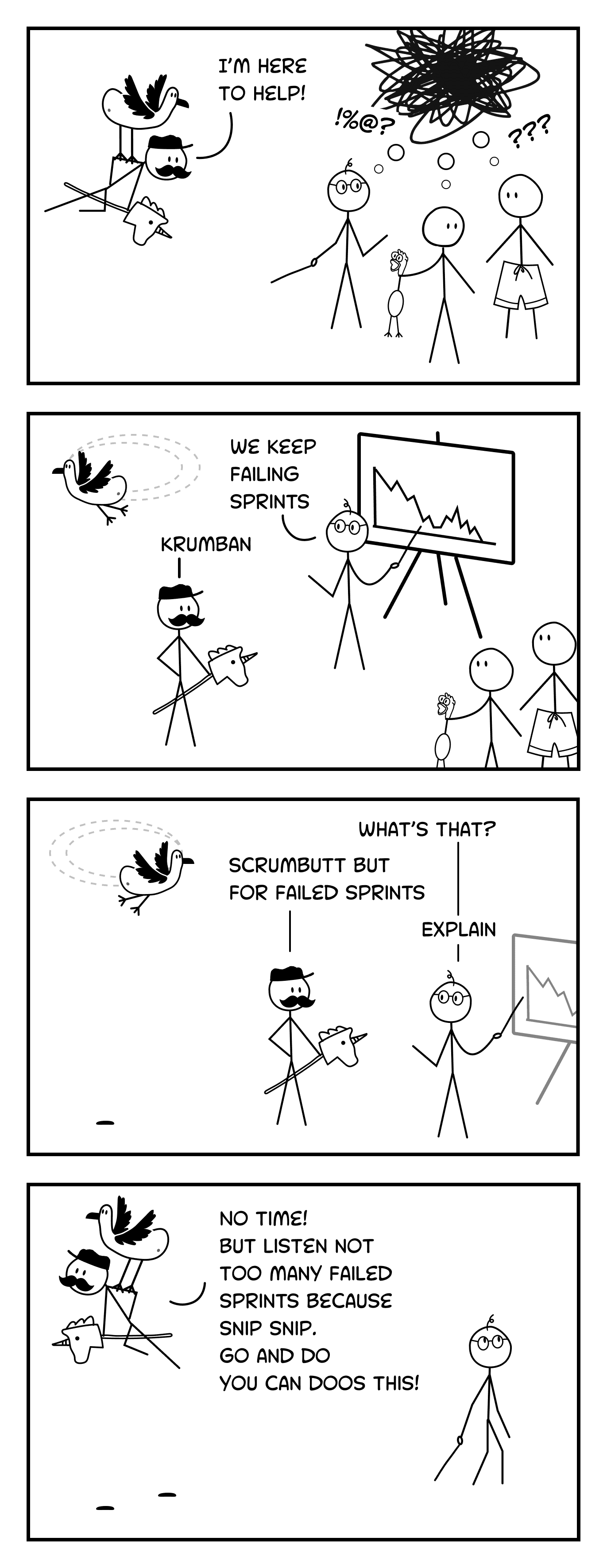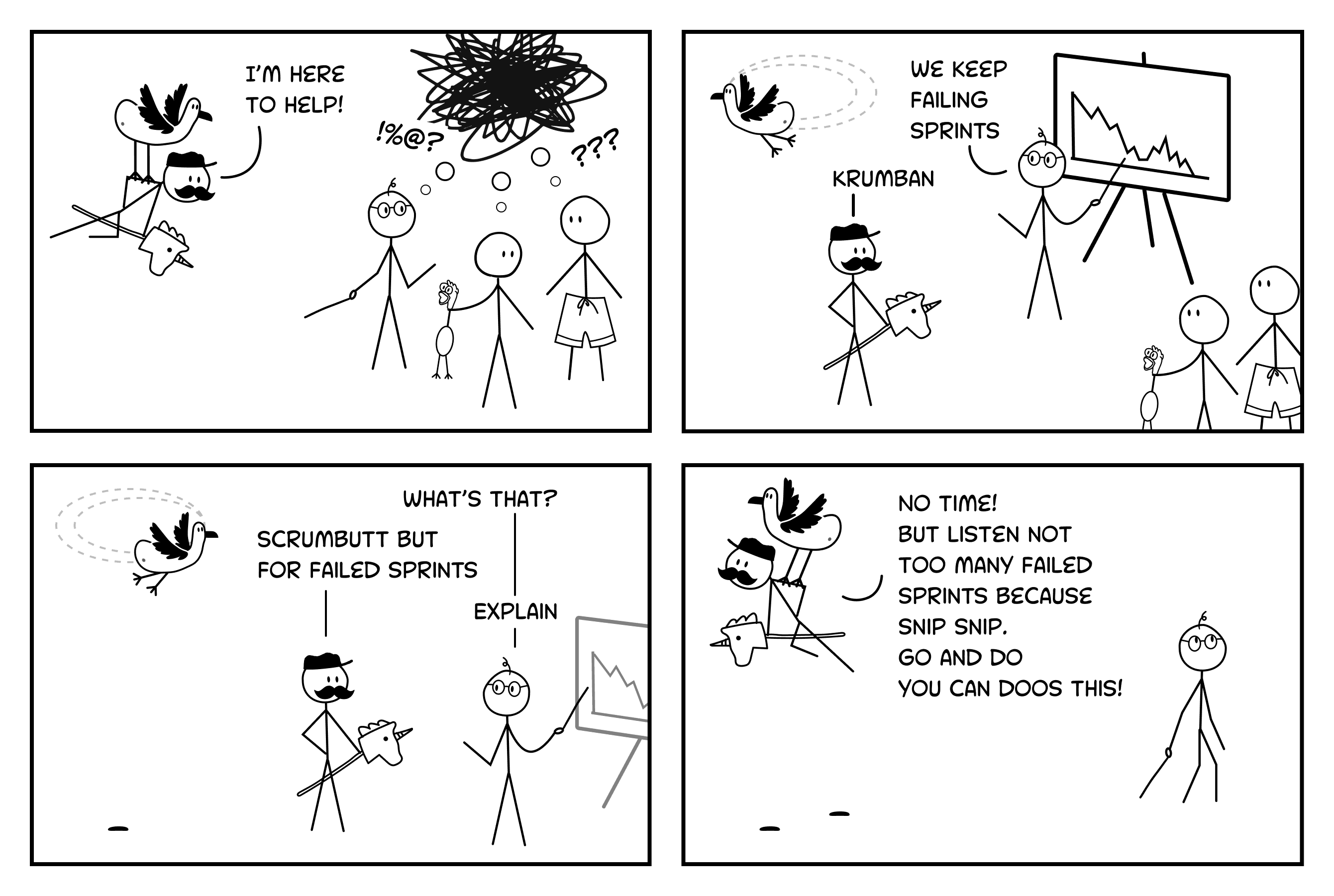
Geo
November 21, 2024
The One With The Seagull Leader
"GWAAAAK" - Seagull
What is Seagull leadership?
Seagulls are intrepid creatures—loud, bold, and always making their presence known. They swoop in unexpectedly, squawk incessantly, scatter everyone around them, and often leave a mess in their wake. While this behavior is perfectly natural for seagulls, it’s a disaster when mimicked by leaders.
In the world of Agile software development, we’ve all encountered a "seagull leader"—someone who flies in sporadically, disrupts the flow, offers vague or unhelpful advice, and then vanishes, leaving the team to clean up the chaos. Much like their avian counterparts, these leaders thrive on noise and activity, but their interventions often do more harm than good.
For example, a seagull leader might drop into a sprint halfway through, announce, "We’re not moving fast enough—everyone needs to pick up the pace!" without understanding why progress might be slower. This vague directive leaves the team scrambling to interpret and act on it while derailing their original priorities.
If this sounds familiar, don’t worry—you’re not alone. Let’s dive into what defines seagull leadership, its impact on Agile teams, and how to avoid becoming (or dealing with) one.
Traits of a Seagull Leader
Inconsistent Presence: Sporadically appears during crises, offering input without understanding context or day-to-day team efforts.
Loud and Disruptive: Dominates discussions with vague, forceful opinions, creating more confusion than clarity.
Unclear Guidance: Provides ambiguous advice like "fix it" or "do better," leaving teams guessing.
Micromanages Without Insight: Overrides team decisions or processes without grasping technical or Agile principles.
Overpromises Externally: Commits to unrealistic deadlines without consulting the team, creating unnecessary chaos.
Short-Term Focus: Pushes for quick fixes that lead to technical debt or long-term problems.
Undermines Team Autonomy: Questions decisions, erodes trust, and disrupts self-organization.
Leaves Teams Cleaning Up: Disappears after intervening, leaving the team to fix the resulting mess.
Ignores Agile Processes: Disregards ceremonies, sprint goals, and backlogs, often working against the framework.
Shifts Blame: Takes credit for wins but blames the team for failures, damaging morale and trust.
The Impact of Seagull Leadership on Agile Teams
Agile teams are designed to thrive on clarity, consistency, and trust. These elements form the backbone of their ability to deliver value in iterative cycles, continuously improving along the way. However, when a seagull leader swoops in, these foundations are shaken, leaving the team scrambling to regain their footing.
The first casualties of seagull leadership is direction. Agile teams operate best when everyone shares a clear understanding of goals and priorities. This alignment allows them to make decisions with confidence and stay focused on delivering value. But a seagull leader tends to arrive unannounced, offering incomplete or contradictory advice. Instead of clarity, they leave behind confusion, forcing teams to waste time interpreting—or worse, guessing—what the leader actually wants. This ambiguity creates chaos in an environment that thrives on precision.
It undermines team autonomy. Agile frameworks, like Scrum or Kanban, are designed to empower teams to make decisions, adapt to challenges, and self-organize around their work. But a seagull leader disrupts this balance by micromanaging or second-guessing decisions. They don’t trust the team’s expertise and often swoop in to impose their will without fully understanding the context. This type of interference erodes the very trust and empowerment Agile teams rely on to succeed.
It leads to wasted effort. Tasks get derailed, sprints lose focus, and progress grinds to a halt. Instead of moving the project forward, the team is left cleaning up the mess or reworking tasks that didn’t align with the original objectives. Agile thrives on maximizing value within short timeframes; seagull leadership does the opposite by draining time and energy on unnecessary adjustments.
It takes a toll on morale. Agile teams work best when they feel supported, understood, and trusted by their leadership. When those qualities are absent—when leaders drop in to critique without context or impose direction without collaboration—frustration builds. Over time, this frustration can turn into disengagement, leading to higher turnover and a lack of trust in leadership. Teams stop feeling like they are part of a cohesive effort and instead feel like they’re just surviving the chaos.
In Agile, where trust, clarity, and collaboration are paramount, seagull leadership is a recipe for dysfunction. Addressing this challenge starts with recognizing its impact and committing to a more supportive and consistent approach—because great Agile teams deserve great leadership.
How to Avoid Seagull Leadership in Agile
Agile is a mindset. And effective leadership within Agile requires more than just a surface understanding or sporadic involvement. If you’ve found yourself swooping in with well-intentioned advice that seems to create more confusion than clarity, it might be time to rethink your approach. Here’s how you can ensure you’re leading in a way that truly supports your team and avoids the pitfalls of seagull leadership.
Commit to Understanding Agile
Agile leadership starts with knowing what Agile actually is—not just the buzzwords, but the principles and practices that drive its success. If terms like “sprint retrospective” or “WIP limits” are unfamiliar, it’s a sign that there’s work to do. Leaders who truly understand frameworks like Scrum or Kanban are better equipped to provide meaningful guidance and support.
It’s not enough to sit on the sidelines. Attend key team ceremonies like retrospectives or daily standups, not to micromanage but to observe how the team collaborates and where challenges arise. By engaging consistently and learning how Agile processes function in practice, you’ll be able to offer informed input when it’s needed. Agile thrives on trust and alignment, and that starts with leaders who understand and respect the system.
Provide Clear, Actionable Input
Agile teams hate vague feedback—it’s the equivalent of handing a developer a bug report that says, “It doesn’t work.” Similarly, saying “This sprint isn’t going well” or “We need to move faster” without context or specifics doesn’t help anyone. If you notice something is off, take the time to pinpoint what’s wrong and offer actionable suggestions.
For example, instead of saying, “The team isn’t delivering,” dive into the data: Is the backlog unclear? Are priorities shifting mid-sprint? Does the team have blockers they’re struggling to resolve? If you don’t have the answers, collaborate with the team to uncover them. Leadership isn’t about knowing everything—it’s about asking the right questions and working alongside the team to find solutions.
Managing Seagull Leadership as an Agile Team
Dealing with a seagull leader can be frustrating for any Agile team. While the ultimate responsibility for changing this behavior rests with the leader, Agile teams are not powerless. By adopting specific strategies, you can mitigate the impact of disruptive leadership and maintain your focus on delivering value.
Seek Clarity
One of the most common traits of seagull leadership is vague, incomplete direction. When a leader provides unclear guidance, the best response is to ask specific, targeted questions to uncover their goals and expectations. Instead of trying to interpret their intent, steer the conversation toward actionable outcomes.
For example, if a leader says, “This sprint isn’t working,” respond with clarifying questions like, “What specific problem are we trying to solve?” or “What is the highest priority we should focus on right now?” By probing for specifics, you not only get the clarity you need but also encourage the leader to think more deeply about their input.
Leverage Agile Artifacts
Agile provides a wealth of tools to structure work and maintain alignment—sprint goals, prioritized backlogs, and clearly defined ceremonies. These artifacts can act as anchors when dealing with disruptive leadership.
For instance, if a seagull leader swoops in mid-sprint with a new set of priorities, refer back to the sprint goal: “How does this fit with what we committed to for this sprint?” Similarly, backlog prioritization can serve as a guardrail for shifting requests, helping the team maintain focus and reduce unnecessary churn.
By leaning on these artifacts, you can ground conversations in the existing process, keeping the team aligned and minimizing distractions.
Communicate Transparently
One of the best ways to manage seagull leadership is through proactive, transparent communication. Regularly update stakeholders and leaders on your progress, challenges, and risks to reduce the likelihood of sudden interventions.
For example, share sprint reviews or reports that highlight what’s working and where the team could use support. When leaders feel informed, they are less likely to jump in unannounced with vague directives. Transparency not only builds trust but also helps maintain the team’s focus on its goals.
Focus on Outcomes
Seagull leaders often fixate on immediate tasks or issues without considering the bigger picture. As a team, it’s important to redirect these conversations toward outcomes and value delivery.
For instance, if a leader demands a mid-sprint pivot, frame the discussion around its impact on value delivery: “How does this change align with the value creation story?” By focusing on outcomes, you help the team and leadership stay aligned on what truly matters, reducing knee-jerk reactions and unnecessary rework.
Document Decisions
In Agile, decisions and priorities can shift quickly, especially when dealing with disruptive leadership. To ensure accountability and clarity, document leadership input and decisions in your Agile tools, like Jira or Confluence.
When a leader provides direction, log it as part of the sprint or backlog discussion. This creates a transparent record of what was requested and why, which can be referenced later if priorities shift again. Documentation helps the team stay organized and provides a safety net for future conversations.
Breaking Free
Seagull leadership is a counterproductive approach that Agile teams must navigate carefully. It disrupts workflows, undermines trust, and prevents teams from realizing their full potential. By understanding the damage this style causes, leaders can shift toward consistent, supportive, and empowering practices. Agile teams, in turn, can leverage their processes and tools to minimize disruption and stay focused on delivering value.
True Agile leadership is about fostering collaboration, enabling autonomy, and supporting teams through challenges—not swooping in, stirring up chaos, and flying away. With intentional effort on both sides, Agile teams can overcome the pitfalls of seagull leadership and continue building software that delivers real value.



